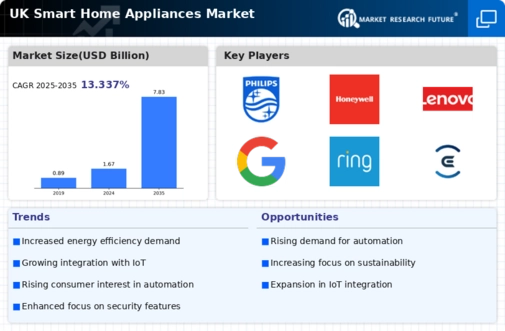The smart home-appliances market is currently characterized by a dynamic competitive landscape, driven by rapid technological advancements and evolving consumer preferences. Key players such as Amazon (US), Google (US), and Samsung (KR) are at the forefront, each adopting distinct strategies to enhance their market positioning. Amazon (US) continues to leverage its extensive ecosystem, integrating smart home devices with its Alexa platform, thereby fostering a seamless user experience. Google (US), on the other hand, emphasizes AI-driven innovations, enhancing its Nest product line to offer more personalized and efficient home automation solutions. Samsung (KR) focuses on expanding its SmartThings platform, promoting interoperability among various devices, which is crucial in a market that increasingly values connectivity and user convenience.
In terms of business tactics, companies are increasingly localizing manufacturing and optimizing supply chains to enhance efficiency and reduce costs. The market structure appears moderately fragmented, with a mix of established players and emerging startups. This fragmentation allows for diverse offerings, yet the collective influence of major companies like Amazon (US) and Google (US) shapes competitive dynamics significantly, as they set benchmarks for innovation and customer engagement.
In October 2025, Amazon (US) announced a strategic partnership with a leading energy provider to integrate smart home devices with renewable energy solutions. This move is pivotal as it aligns with the growing consumer demand for sustainability, allowing users to monitor and manage their energy consumption more effectively. Such initiatives not only enhance Amazon's product appeal but also position the company as a leader in promoting eco-friendly technologies within the smart home sector.
In September 2025, Google (US) unveiled a new AI feature for its Nest Hub, enabling users to control their home environment through advanced voice recognition. This development underscores Google's commitment to enhancing user experience through cutting-edge technology. By prioritizing AI integration, Google (US) is likely to strengthen its competitive edge, appealing to tech-savvy consumers who seek intuitive and responsive home automation solutions.
In August 2025, Samsung (KR) launched a new line of smart appliances that utilize IoT technology to optimize energy efficiency. This initiative reflects a broader trend towards sustainability and energy conservation in the smart home-appliances market. By focusing on energy-efficient products, Samsung (KR) not only meets regulatory demands but also caters to environmentally conscious consumers, thereby enhancing its market share.
As of November 2025, the competitive trends in the smart home-appliances market are increasingly defined by digitalization, sustainability, and AI integration. Strategic alliances are becoming more prevalent, as companies recognize the value of collaboration in enhancing product offerings and market reach. Looking ahead, competitive differentiation is expected to evolve, shifting from price-based competition to a focus on innovation, technology, and supply chain reliability. This transition suggests that companies that prioritize R&D and sustainable practices will likely emerge as leaders in this rapidly evolving market.























Leave a Comment